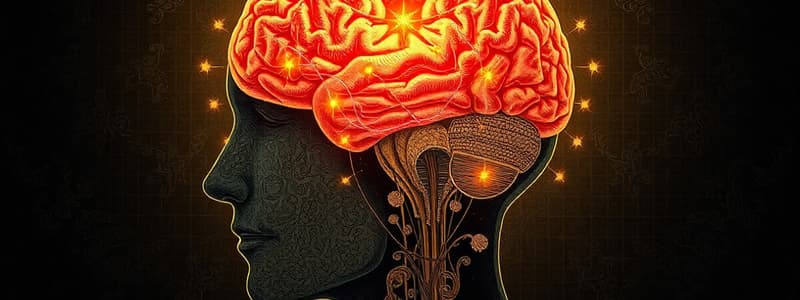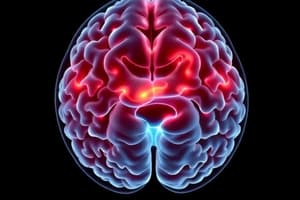Podcast
Questions and Answers
What is a common symptom associated with thrombosed ophthalmic artery?
What is a common symptom associated with thrombosed ophthalmic artery?
- Severe headache
- Transient loss of vision (correct)
- Difficulty speaking
- Sudden dizziness
What distinguishes anterior circulation strokes from posterior circulation strokes within the first 24 hours?
What distinguishes anterior circulation strokes from posterior circulation strokes within the first 24 hours?
- Impaired judgment (correct)
- Loss of consciousness
- Lower limb paralysis
- Visual agnosia
Which of the following risk factors is most commonly associated with hemorrhagic stroke?
Which of the following risk factors is most commonly associated with hemorrhagic stroke?
- High cholesterol
- Diabetes mellitus
- Cerebral amyloid angiopathy (correct)
- Atrial fibrillation
What transportation protocol is recommended for patients with suspected large vessel occlusion stroke?
What transportation protocol is recommended for patients with suspected large vessel occlusion stroke?
Which imaging method is most capable of identifying parenchymal hemorrhages greater than 1 cm?
Which imaging method is most capable of identifying parenchymal hemorrhages greater than 1 cm?
What is NOT typically a symptom of posterior circulation strokes?
What is NOT typically a symptom of posterior circulation strokes?
Which stroke center provides the capability for advanced surgical and endovascular interventions?
Which stroke center provides the capability for advanced surgical and endovascular interventions?
In diagnosing ischemic stroke, how soon can early ischemic changes appear on a CT scan?
In diagnosing ischemic stroke, how soon can early ischemic changes appear on a CT scan?
Which type of stroke accounts for the majority of cases?
Which type of stroke accounts for the majority of cases?
What is the in-hospital mortality rate for hemorrhagic stroke?
What is the in-hospital mortality rate for hemorrhagic stroke?
Which symptom is NOT typically associated with a transient ischemic attack (TIA)?
Which symptom is NOT typically associated with a transient ischemic attack (TIA)?
What is the primary treatment recommendation for high-risk TIA patients?
What is the primary treatment recommendation for high-risk TIA patients?
Which mnemonic helps in reading a CT head in emergency settings?
Which mnemonic helps in reading a CT head in emergency settings?
Which of the following conditions crosses sutures but does not cross the midline?
Which of the following conditions crosses sutures but does not cross the midline?
What does a low ABCD2 score indicate for TIA patients?
What does a low ABCD2 score indicate for TIA patients?
What should be examined to evaluate for intracranial pressure on a CT head scan?
What should be examined to evaluate for intracranial pressure on a CT head scan?
What is the primary purpose of the NIHSS scoring tool?
What is the primary purpose of the NIHSS scoring tool?
Which subtle early ischemic change is NOT associated with increased risk of intracranial hemorrhage?
Which subtle early ischemic change is NOT associated with increased risk of intracranial hemorrhage?
What should be the target blood glucose level for a patient after a stroke?
What should be the target blood glucose level for a patient after a stroke?
Which condition is a contraindication for administering IV thrombolytic therapy with alteplase?
Which condition is a contraindication for administering IV thrombolytic therapy with alteplase?
What is the recommended blood pressure for administering tPA in patients with acute ischemic stroke?
What is the recommended blood pressure for administering tPA in patients with acute ischemic stroke?
Which of the following statements is true regarding the use of aspirin after a stroke?
Which of the following statements is true regarding the use of aspirin after a stroke?
What is the maximum dosage for alteplase in patients receiving thrombolytic therapy?
What is the maximum dosage for alteplase in patients receiving thrombolytic therapy?
What should be avoided to help in the management of patients with stroke?
What should be avoided to help in the management of patients with stroke?
What was the outcome of the ENCHANTED trial regarding low dose alteplase compared to standard dose alteplase?
What was the outcome of the ENCHANTED trial regarding low dose alteplase compared to standard dose alteplase?
Which patient scenario would allow the administration of IV alteplase?
Which patient scenario would allow the administration of IV alteplase?
What is the recommendation from AHA/ASA regarding the dose of alteplase for treatment?
What is the recommendation from AHA/ASA regarding the dose of alteplase for treatment?
What effect does tenecteplase have compared to alteplase according to the EXTEND-IA TNK trial?
What effect does tenecteplase have compared to alteplase according to the EXTEND-IA TNK trial?
What precautions should be taken when monitoring a patient following thrombolysis?
What precautions should be taken when monitoring a patient following thrombolysis?
What is a common complication associated with IV alteplase treatment?
What is a common complication associated with IV alteplase treatment?
What characterizes the intake of aspirin and clopidogrel prior to stroke treatment?
What characterizes the intake of aspirin and clopidogrel prior to stroke treatment?
What is the initial dosing recommendation for administering ticagrelor?
What is the initial dosing recommendation for administering ticagrelor?
What is the recommended initial treatment for a patient diagnosed with symptomatic intracerebral hemorrhage (ICH)?
What is the recommended initial treatment for a patient diagnosed with symptomatic intracerebral hemorrhage (ICH)?
Which factor is NOT a risk indicator for bleeding in patients with suspected stroke?
Which factor is NOT a risk indicator for bleeding in patients with suspected stroke?
In the comparison of mechanical thrombectomy versus dual therapy, what was a notable outcome of dual therapy?
In the comparison of mechanical thrombectomy versus dual therapy, what was a notable outcome of dual therapy?
Which of the following reversal agents is appropriate for a Vitamin K antagonist with an INR greater than 1.4?
Which of the following reversal agents is appropriate for a Vitamin K antagonist with an INR greater than 1.4?
What condition is indicated for surgical evacuation in intracerebral hemorrhage management?
What condition is indicated for surgical evacuation in intracerebral hemorrhage management?
Which of the following statements about hemorrhagic stroke management is true?
Which of the following statements about hemorrhagic stroke management is true?
Which neurological symptom is characterized by an inability to recognize objects despite intact sensory function?
Which neurological symptom is characterized by an inability to recognize objects despite intact sensory function?
Which treatment has shown to be potentially more effective than mannitol in managing intracranial pressure?
Which treatment has shown to be potentially more effective than mannitol in managing intracranial pressure?
Flashcards are hidden until you start studying
Study Notes
Stroke
- Stroke is any vascular injury that reduces cerebral blood flow (CBF) to the brain, retina, or spinal cord, causing neurologic impairment.
- 87% of all strokes are ischemic in origin, 13% are hemorrhagic strokes
- Ischemic stroke has an in-hospital mortality rate of 5% to 10%
- Hemorrhagic stroke has an in-hospital mortality rate of 40% to 60%
- Only 10% of stroke survivors will recover completely.
Transient Ischemic Attack (TIA)
- TIA is a transient episode of neurologic dysfunction caused by focal brain, spinal cord, or retinal ischemia, without acute infarction.
- Symptoms of TIA typically last less than 20 minutes.
- 10% of TIA patients will have a stroke within 90 days.
Risk Factors for TIA
- Hypertension
- Diabetes mellitus
- Symptoms lasting ≥ 10 minutes
- Motor deficits
- Speech impairment
ABCD2 Score
- Used to assess the risk of stroke after a TIA.
- A score of ≥ 4 indicates a high-risk of stroke within 90 days.
NIHSS Score (National Institutes of Health Stroke Scale)
- Used to assess neurologic deficit in stroke patients.
- A score > 3 indicates a moderate to major ischemic stroke.
Treatment for Stroke
- Low-risk TIA or moderate to major ischemic stroke (NIHSS > 3) are treated with aspirin alone.
- High-risk TIA (ABCD2 score ≥ 4) or minor ischemic stroke (NIHSS score ≤ 3) are treated with aspirin and other medications.
- IV thrombolytic therapy and mechanical thrombectomy are used in acute stroke.
CT Head Assessment
- Use the mnemonic "Blood Can Be Very Bad" to remember what to look for in a CT head:
- Blood - Look for blood in the cisterns (subarachnoid hemorrhage).
- Can - Check the cisterns for signs of high intracranial pressure.
- Be - Assess brain symmetry, sulci/gyri appearances, gray-white differentiation, and any brain shift.
- Very - Examine the ventricles for dilation or compression/shift, and vessels for signs of clot.
- Bad - Evaluate the bones for fractures or other abnormalities.
Anterior Circulation Stroke
- Symptoms progress within the first 24 hours.
- Rarely includes loss of consciousness (LOC).
- Frontal lobe dysfunction: AMS (altered mental status), impaired judgment and insight.
- Paralysis and hypesthesia (decreased sensation) of the lower limb contralaterally (opposite side).
- Ipsilateral (same side) Hemianopsia (blindness in half of the visual field).
- Agnosia (inability to recognize objects) on the dominant side of the brain.
- Aphasia (inability to speak) on the dominant side of the brain.
Posterior Circulation Stroke
- Symptoms progress for up to 3 days.
- LOC + N/V (nausea and vomiting).
- Brain stem and cerebellar dysfunction: Vertigo, dysphagia (difficulty swallowing), spasticity, ataxia (loss of coordination), and nystagmus (involuntary eye movements).
- Crossed deficits (symptoms on one side of the body with the other side unaffected).
- Homonymous hemianopsia (blindness in the same half of the visual field on both eyes).
- Visual agnosia (inability to recognize objects seen).
- Alexia (inability to read) + dysarthria (difficulty speaking).
Hemorrhagic Stroke
- Clinical presentation can be similar to ischemic stroke.
- 30-day mortality rate of up to 50%.
- Hypertension and cerebral amyloid angiopathy are most common risk factors.
Pre-Hospital Stroke Assessment
- Mission: Lifeline Severity-based Stroke Triage Algorithm for EMS recommends transport to a comprehensive stroke center for suspected large vessel occlusion stroke if travel time is < 15 minutes longer than the closest primary stroke center.
Stroke Centers
- ASRH (Acute Stroke Ready Hospital) - Establishes initial stroke diagnosis and provides initial care.
- PSC (Primary Stroke Center) - Offers stroke infrastructure, including a stroke team, stroke unit, patient care protocols, and support services, including CT and lab testing availability.
- CSC (Comprehensive Stroke Center) - Offers advanced imaging modalities, performs surgical and endovascular interventions, and has a stroke unit and stroke registry.
Management of Stroke
- Maintain airway.
- Prevent dehydration and fluid overload.
- Keep oxygen saturation above 95%.
- Maintain blood glucose level at 140-180 mg/dl.
BP Control
- For patients receiving tPA: Less than 185/110 mmHg.
- For patients not receiving tPA: Less than 220/120 mmHg or a mean arterial pressure (MAP) of 130.
Reperfusion Therapy
- IV thrombolytic therapy: Uses IV alteplase to dissolve the blood clot.
- Mechanical thrombectomy: Uses a catheter to remove the clot.
IV Alteplase Therapy
- Eligibility: Patients must meet certain criteria, including time of onset, NIHSS score, and prior medical history.
- Contraindications include: Onset time > 3 or 4.5 hours, history of ICH, ischemic stroke within 3 months, SAH, BP > 185/110, GI/GU bleed within 21 days, coagulopathy, LMWH within 24 hours, or DOAC use within 48 hours.
Aspirin Therapy
- Recommended for patients not eligible for tPA within 24-48 hours of symptom onset.
Alteplase and Tenecteplase Dosage
- Alteplase 0.9 mg/kg IV (maximum 90mg) over 60 minutes.
- Tenecteplase 0.25 mg/kg IV (maximum 25mg) single bolus over 1 minute.
Low-Dose Alteplase (ENCHANTED Trial)
- Low-dose (0.6 mg/kg) was non-inferior to standard dose (0.9 mg/kg) in terms of death and disability at 90 days.
- Fewer symptomatic ICH with low-dose alteplase (1.0%) compared to standard dose (2.1%).
- Low-dose is current practice in Japan, but AHA/ASA recommend standard dose.
Tenecteplase (EXTEND-IA TNK Trial)
- Tenecteplase had higher incidence of reperfusion and better functional outcome compared to alteplase.
- ICH was similar in both groups.
Thrombolysis in Patients on Anticoagulants
- Avoid administering IV alteplase to patients who have received a full treatment dose of LMWH within the previous 24 hours.
- Avoid alteplase for patients taking direct thrombin inhibitors or direct factor Xa inhibitors.
- Refer to specific guidelines for managing patients on anticoagulants.
Symptomatic Intracerebral Hemorrhage (ICH) Following Thrombolysis
- This is a serious complication that can occur after tPA treatment.
- Typically occurs within 36 hours after infusion.
- Symptoms: neurological deterioration, and new or worsening neurologic deficits.
- Requires monitoring for 24 hours in the ICU.
- Treatment includes cardiovascular and respiratory support, BP management, neurological monitoring, prevention of hematoma expansion, control of ICP, and seizure control.
Mechanical Thrombectomy
- Candidates for mechanical thrombectomy:
- Patients with last known normal time less than 24 hours.
- Proximal LVO (M1 branch of MCA, ICA, basilar artery).
- Moderate to severe stroke symptoms.
- Meeting DAWN or DEFUSE3 eligibility criteria.
- Other inclusion criteria determined by neurology and interventional radiology.
- Dual therapy (thrombectomy and IV thrombolytics) is associated with a higher likelihood of 3-month functional independence and lower odds of 3-month mortality compared to thrombectomy alone.
- No randomized control trials of mechanical thrombectomy for posterior circulation LVO.
Hemorrhagic Stroke Management
- Intensive monitoring of airway, BP, ICP control, seizures, and herniation prevention.
Reversal of Anticoagulants
- Vitamin K antagonists (INR > 1.4): IV Vitamin K or 3,4 PCC, FFP.
- Dapigatran: Idarucizumab, PCC, FFP.
- Factor Xa inhibitors: Andexanet alfa, 4 PCC.
- COX inhibitors or ADP receptor inhibitors: Desmopressin.
- Platelet transfusion?
ICP Management
- Hypertonic saline (HTS) or mannitol: Some trials showed HTS is more effective than mannitol.
- Avoid hypo or hyperglycemia.
- Avoid fever.
- Corticosteroids are not recommended.
- Sedation and seizure control.
Surgical Evacuation
- Indicated for supratentorial ICH, neurological deterioration, coma, midline shift, or high ICP refractory to medical management.
- Minimally invasive surgical approach is preferred over open craniotomy.
Agnosia
- An inability to recognize objects, persons, sounds, shapes, or smells while the specific sense is not defective nor is there any significant memory loss.
Aphasia
- An inability to comprehend or formulate language because of damage to specific brain regions.
Visual Agnosia
- The inability to recognize seen objects despite seemingly intact visual perception
Studying That Suits You
Use AI to generate personalized quizzes and flashcards to suit your learning preferences.




